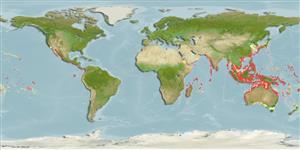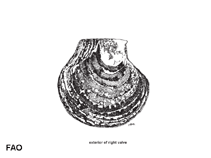Isognomon ephippium (Linnaeus, 1758)
Saddle tree oyster| Native range | All suitable habitat | Point map | Year 2050 |

|
| This map was computer-generated and has not yet been reviewed. |
| Isognomon ephippium AquaMaps Data sources: GBIF OBIS |
Classification / Names Common names | Synonyms | CoL | ITIS | WoRMS
Bivalvia | Ostreida | Isognomonidae
Environment: milieu / climate zone / depth range / distribution range Ecology
Benthic; brackish. Tropical
Distribution Countries | FAO areas | Ecosystems | Occurrences | Introductions
Indo-West Pacific: from East Africa, to Melanesia; north to Japan and south to Indonesia.
Length at first maturity / Size / Weight / Age
Maturity: Lm ? range ? - ? cm Max length : 14.0 cm SHL male/unsexed; (Ref. 348); common length : 10.0 cm SHL male/unsexed; (Ref. 348)
Short description Morphology
Shell variable, irregularly rounded in outline, with height about equal to length. Dorsal margin straight and relatively short, not expanded posteriorly in a wing-like ear. Anterior margin sharply sinuous dorsally, ventrally strongly convex and extending well forward of umbones. Posterior margin slightly concave, forming an obsolete angulation with the rounded ventral margin. Umbones small, pointing at anterior end of dorsal margin. Outer surface covered with concentric lamellar processes, with very low radial ridge ending at posteroventral angulation. Ligamental area with a dozen transverse grooves. Nacreous area of the inner side of shell surrounded by a broad, non-nacreous margin. Colour: outside of shell horny to purplish brown. Interior nacreous, with a broad dark brown margin.
Attached to rocks and other hard substrates, in marine and brackish water areas (Ref. 348), with sandy and muddy bottoms (Ref. 128042). Common in muddy estuaries and mangrove where it attaches to prop roots. Littoral and shallow subtidal levels (Ref. 348).
Life cycle and mating behavior Maturity | Reproduction | Spawning | Eggs | Fecundity | Larvae
Members of the class Bivalvia are mostly gonochoric, some are protandric hermaphrodites. Life cycle: Embryos develop into free-swimming trocophore larvae, succeeded by the bivalve veliger, resembling a miniature clam.
Main reference
References | Coordinator | Collaborators
Poutiers, J.M. 1998. (Ref. 348)
IUCN Red List Status (Ref. 130435)
CITES status (Ref. 108899)
Not Evaluated
CMS (Ref. 116361)
Not Evaluated
Threat to humans
Harmless
Human uses
| FishSource |
Tools
More information
Internet sources
BHL | BOLD Systems | CISTI | DiscoverLife | FAO(Publication : search) | Fishipedia | GenBank (genome, nucleotide) | GloBI | Gomexsi | Google Books | Google Scholar | Google | PubMed | Tree of Life | Wikipedia (Go, Search) | Zoological Record
Estimates based on models
Preferred temperature
(Ref. 115969): 23.9 - 29.3, mean 28.4 (based on 3365 cells).
Price category
(Ref. 80766):
Unknown.



